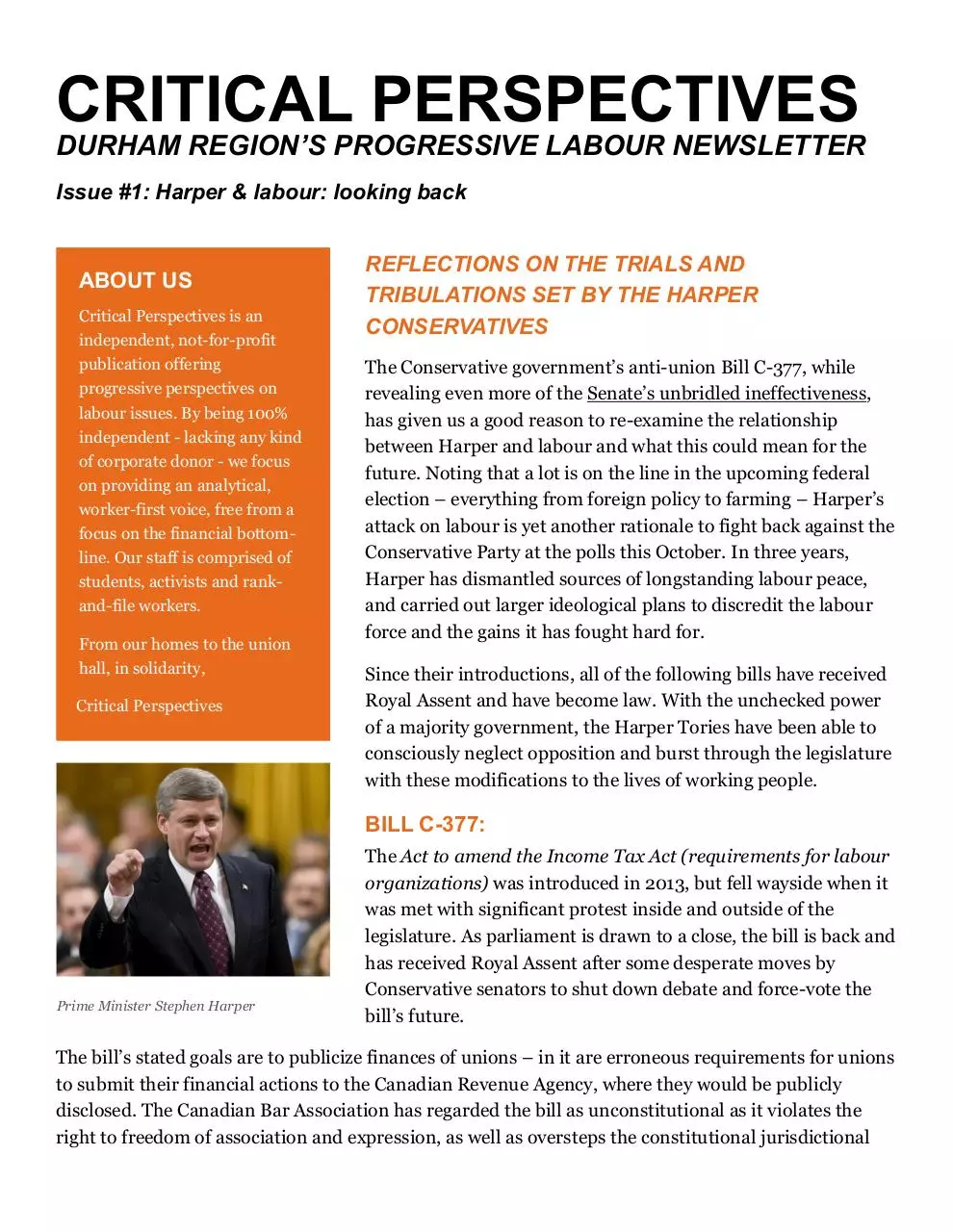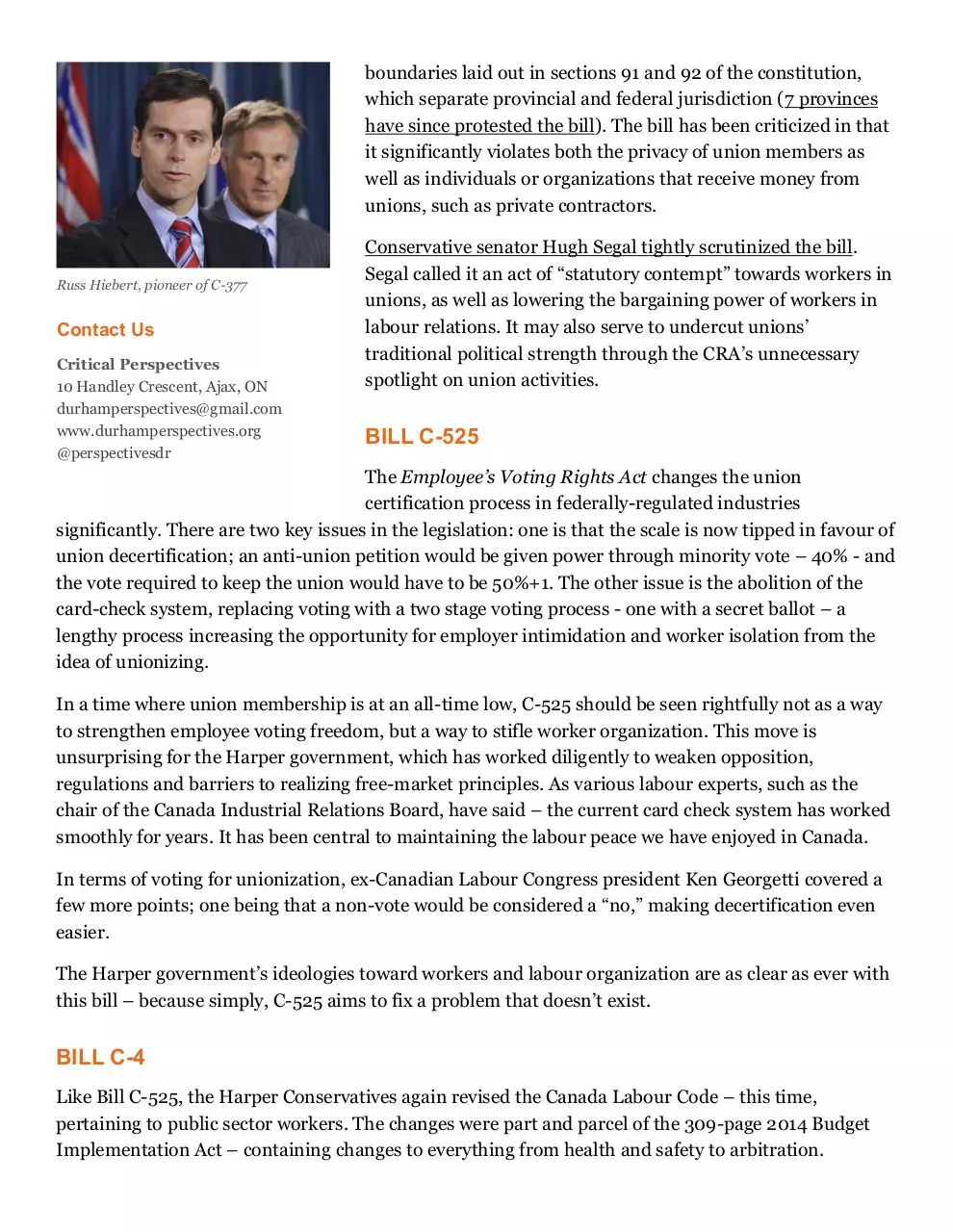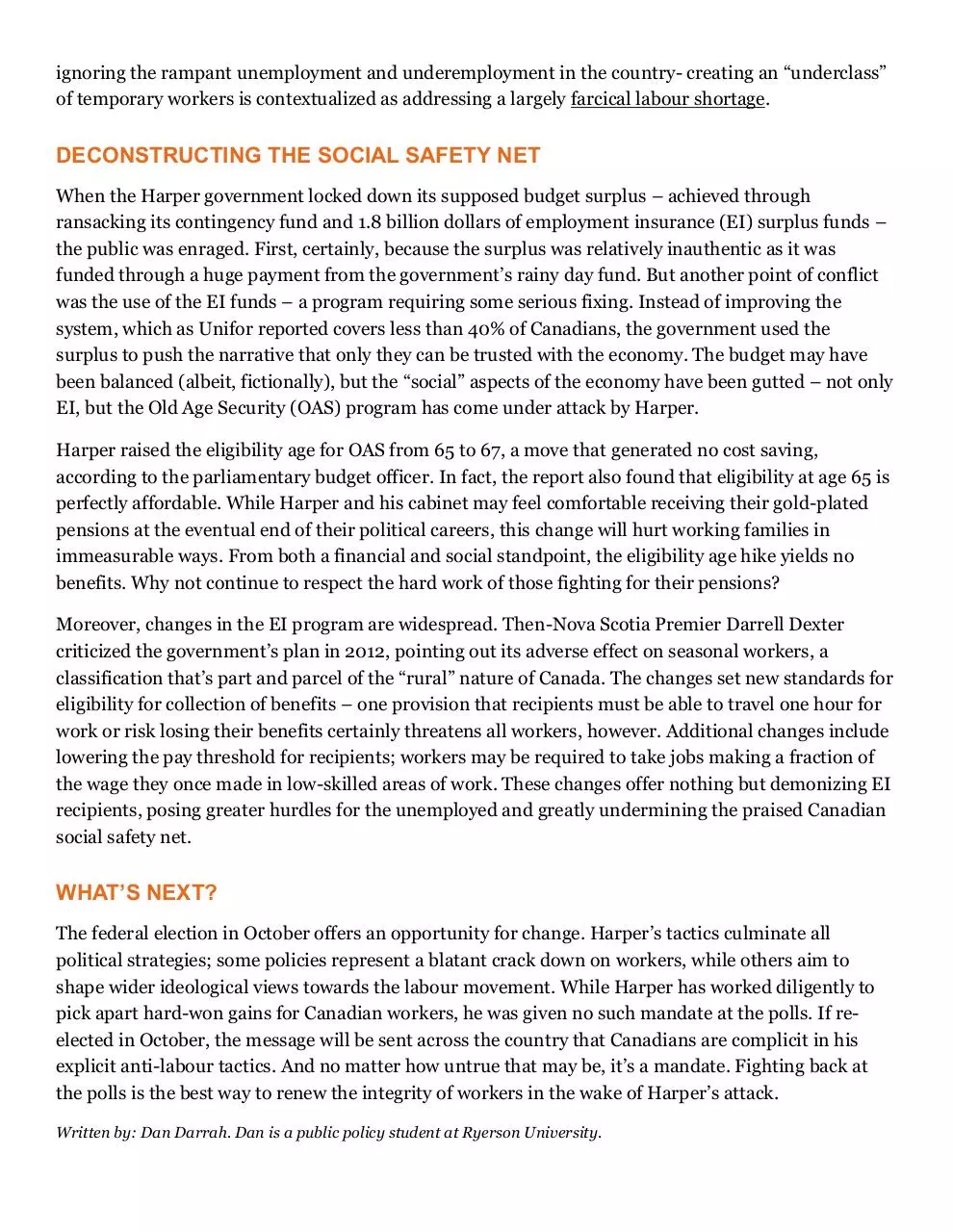CRITICAL PERSPECTIVE1 (PDF)
File information
Author: Dan Darrah
This PDF 1.5 document has been generated by Microsoft® Word 2013, and has been sent on pdf-archive.com on 25/07/2015 at 16:22, from IP address 99.243.x.x.
The current document download page has been viewed 897 times.
File size: 362.43 KB (4 pages).
Privacy: public file




File preview
CRITICAL PERSPECTIVES
DURHAM REGION’S PROGRESSIVE LABOUR NEWSLETTER
Issue #1: Harper & labour: looking back
ABOUT US
Critical Perspectives is an
independent, not-for-profit
publication offering
progressive perspectives on
labour issues. By being 100%
independent - lacking any kind
of corporate donor - we focus
on providing an analytical,
worker-first voice, free from a
focus on the financial bottomline. Our staff is comprised of
students, activists and rankand-file workers.
From our homes to the union
hall, in solidarity,
Critical Perspectives
REFLECTIONS ON THE TRIALS AND
TRIBULATIONS SET BY THE HARPER
CONSERVATIVES
The Conservative government’s anti-union Bill C-377, while
revealing even more of the Senate’s unbridled ineffectiveness,
has given us a good reason to re-examine the relationship
between Harper and labour and what this could mean for the
future. Noting that a lot is on the line in the upcoming federal
election – everything from foreign policy to farming – Harper’s
attack on labour is yet another rationale to fight back against the
Conservative Party at the polls this October. In three years,
Harper has dismantled sources of longstanding labour peace,
and carried out larger ideological plans to discredit the labour
force and the gains it has fought hard for.
Since their introductions, all of the following bills have received
Royal Assent and have become law. With the unchecked power
of a majority government, the Harper Tories have been able to
consciously neglect opposition and burst through the legislature
with these modifications to the lives of working people.
BILL C-377:
Prime Minister Stephen Harper
The Act to amend the Income Tax Act (requirements for labour
organizations) was introduced in 2013, but fell wayside when it
was met with significant protest inside and outside of the
legislature. As parliament is drawn to a close, the bill is back and
has received Royal Assent after some desperate moves by
Conservative senators to shut down debate and force-vote the
bill’s future.
The bill’s stated goals are to publicize finances of unions – in it are erroneous requirements for unions
to submit their financial actions to the Canadian Revenue Agency, where they would be publicly
disclosed. The Canadian Bar Association has regarded the bill as unconstitutional as it violates the
right to freedom of association and expression, as well as oversteps the constitutional jurisdictional
boundaries laid out in sections 91 and 92 of the constitution,
which separate provincial and federal jurisdiction (7 provinces
have since protested the bill). The bill has been criticized in that
it significantly violates both the privacy of union members as
well as individuals or organizations that receive money from
unions, such as private contractors.
Russ Hiebert, pioneer of C-377
Contact Us
Critical Perspectives
10 Handley Crescent, Ajax, ON
durhamperspectives@gmail.com
www.durhamperspectives.org
@perspectivesdr
Conservative senator Hugh Segal tightly scrutinized the bill.
Segal called it an act of “statutory contempt” towards workers in
unions, as well as lowering the bargaining power of workers in
labour relations. It may also serve to undercut unions’
traditional political strength through the CRA’s unnecessary
spotlight on union activities.
BILL C-525
The Employee’s Voting Rights Act changes the union
certification process in federally-regulated industries
significantly. There are two key issues in the legislation: one is that the scale is now tipped in favour of
union decertification; an anti-union petition would be given power through minority vote – 40% - and
the vote required to keep the union would have to be 50%+1. The other issue is the abolition of the
card-check system, replacing voting with a two stage voting process - one with a secret ballot – a
lengthy process increasing the opportunity for employer intimidation and worker isolation from the
idea of unionizing.
In a time where union membership is at an all-time low, C-525 should be seen rightfully not as a way
to strengthen employee voting freedom, but a way to stifle worker organization. This move is
unsurprising for the Harper government, which has worked diligently to weaken opposition,
regulations and barriers to realizing free-market principles. As various labour experts, such as the
chair of the Canada Industrial Relations Board, have said – the current card check system has worked
smoothly for years. It has been central to maintaining the labour peace we have enjoyed in Canada.
In terms of voting for unionization, ex-Canadian Labour Congress president Ken Georgetti covered a
few more points; one being that a non-vote would be considered a “no,” making decertification even
easier.
The Harper government’s ideologies toward workers and labour organization are as clear as ever with
this bill – because simply, C-525 aims to fix a problem that doesn’t exist.
BILL C-4
Like Bill C-525, the Harper Conservatives again revised the Canada Labour Code – this time,
pertaining to public sector workers. The changes were part and parcel of the 309-page 2014 Budget
Implementation Act – containing changes to everything from health and safety to arbitration.
One provision, “Division 5 of Part 3 amends the Canada Labour Code to amend the definition of
“danger” in subsection 122(1), to modify the refusal to work process” has come with surmounting
criticism; labour leaders have commentated that the proposed amendments will make refusal to work
in some instances unlawful. Moreover, the bill removes “illness” from Health and Safety provisions.
The Public Service Alliance of Canada (PSAC) have asserted that this change will likely result in
workers being denied protection from “potential chronic or slow developing illnesses based on
exposure to carcinogens.”
The pitfalls of another provision, “Division 17 of Part 3 modernizes the collective bargaining and
recourse systems provided by the Public Service Labour Relations Act regime” were summarized by
Larry Rousseau, Vice President of PSAC. Rousseau regarded the new changes as a “classic attempt to
divide and conquer workers in a given bargaining unit.” The provision states that disputes will not
lead to arbitration unless 80% of workers are deemed as providing “essential” services. Rousseau
went on to say that, “this means that the government would be able to declare 79% of workers in a
bargaining group as essential, deny arbitration, and then force the remaining 21% minority to strike.”
Further aspects of the bill make the last provision even more caustic – other changes to the PSLR
make “essential” workers unable to strike, and allow the government, as the employer, to determine
which workers are essential, ostensibly deciding on the future of labour arbitration and striking. This
gives the government unprecedented power in determining the outcome of disputes.
TEMPORARY FOREIGN WORKERS
While the TFWP was implemented back in 1973, changes to the program in 2013 have yielded
extremely unsavory results for the labour market, domestic workers, and the temporary workers
themselves. With a large portion of TFWs in western Canada, the Alberta Federation of Labour
produced scathing reports of how the program operated in the
province. In the AFL’s official statement, President Gil
Mcgowan pegged the TFW program as misleading for
temporary workers who were expecting permanent residence
and will now be turned away, a creator of both a
“ghettoization” of low-wage workers in service sectors and a
two-tier labour market: one with full mobility rights, and one
Joe Oliver, Minister of Finance, C-4 sponsor
without (the TFWs), as well as creating wage-depression in the
labour market. The CD Howe institute reported that employers began to prefer temporary workers,
desperately trying to justify their usage over domestic workers.
The pushback against the program has occasionally been skewed; those not wishing to sound
xenophobic feel more inclined to support the program. But the truth of the matter is that the TFW
program is not a part of our immigration system: it is labour exploitation with a guise. In fact, the BC
Federation claimed that the program was “outpacing immigration to BC.” And while the program may
be a short-term amelioration of short-term labour shortages, changes by the Harper government have
made it a long-term tool in underhanded employment practices. This has, as such, extended to
ignoring the rampant unemployment and underemployment in the country- creating an “underclass”
of temporary workers is contextualized as addressing a largely farcical labour shortage.
DECONSTRUCTING THE SOCIAL SAFETY NET
When the Harper government locked down its supposed budget surplus – achieved through
ransacking its contingency fund and 1.8 billion dollars of employment insurance (EI) surplus funds –
the public was enraged. First, certainly, because the surplus was relatively inauthentic as it was
funded through a huge payment from the government’s rainy day fund. But another point of conflict
was the use of the EI funds – a program requiring some serious fixing. Instead of improving the
system, which as Unifor reported covers less than 40% of Canadians, the government used the
surplus to push the narrative that only they can be trusted with the economy. The budget may have
been balanced (albeit, fictionally), but the “social” aspects of the economy have been gutted – not only
EI, but the Old Age Security (OAS) program has come under attack by Harper.
Harper raised the eligibility age for OAS from 65 to 67, a move that generated no cost saving,
according to the parliamentary budget officer. In fact, the report also found that eligibility at age 65 is
perfectly affordable. While Harper and his cabinet may feel comfortable receiving their gold-plated
pensions at the eventual end of their political careers, this change will hurt working families in
immeasurable ways. From both a financial and social standpoint, the eligibility age hike yields no
benefits. Why not continue to respect the hard work of those fighting for their pensions?
Moreover, changes in the EI program are widespread. Then-Nova Scotia Premier Darrell Dexter
criticized the government’s plan in 2012, pointing out its adverse effect on seasonal workers, a
classification that’s part and parcel of the “rural” nature of Canada. The changes set new standards for
eligibility for collection of benefits – one provision that recipients must be able to travel one hour for
work or risk losing their benefits certainly threatens all workers, however. Additional changes include
lowering the pay threshold for recipients; workers may be required to take jobs making a fraction of
the wage they once made in low-skilled areas of work. These changes offer nothing but demonizing EI
recipients, posing greater hurdles for the unemployed and greatly undermining the praised Canadian
social safety net.
WHAT’S NEXT?
The federal election in October offers an opportunity for change. Harper’s tactics culminate all
political strategies; some policies represent a blatant crack down on workers, while others aim to
shape wider ideological views towards the labour movement. While Harper has worked diligently to
pick apart hard-won gains for Canadian workers, he was given no such mandate at the polls. If reelected in October, the message will be sent across the country that Canadians are complicit in his
explicit anti-labour tactics. And no matter how untrue that may be, it’s a mandate. Fighting back at
the polls is the best way to renew the integrity of workers in the wake of Harper’s attack.
Written by: Dan Darrah. Dan is a public policy student at Ryerson University.
Download CRITICAL PERSPECTIVE1
CRITICAL PERSPECTIVE1.pdf (PDF, 362.43 KB)
Download PDF
Share this file on social networks
Link to this page
Permanent link
Use the permanent link to the download page to share your document on Facebook, Twitter, LinkedIn, or directly with a contact by e-Mail, Messenger, Whatsapp, Line..
Short link
Use the short link to share your document on Twitter or by text message (SMS)
HTML Code
Copy the following HTML code to share your document on a Website or Blog
QR Code to this page

This file has been shared publicly by a user of PDF Archive.
Document ID: 0000291618.